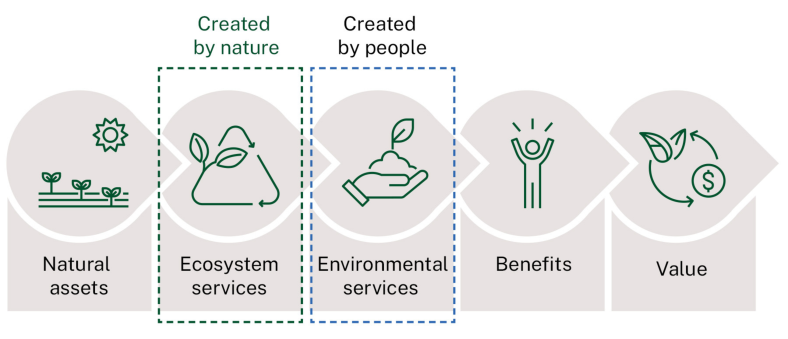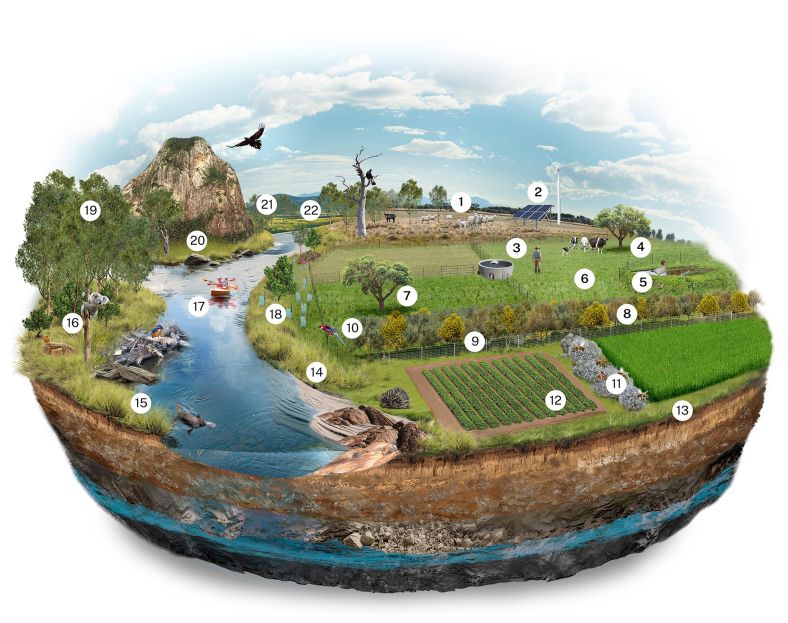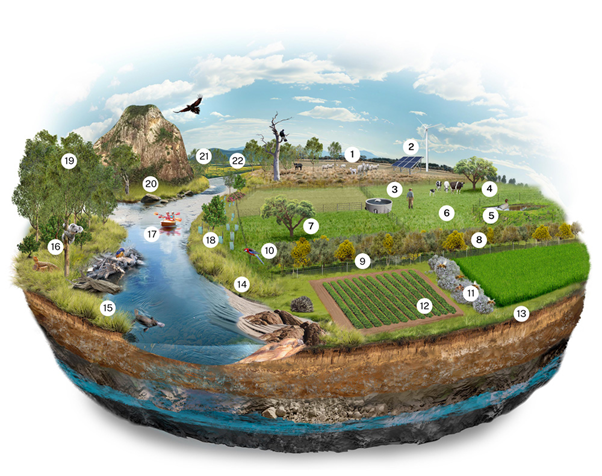Why does natural capital matter?
Around the world, businesses, governments and communities are recognising the importance of protecting, managing and restoring natural capital.
Businesses, banks and supply chains are facing pressure to reduce impacts on nature to meet customer expectations or retain market access.
The concepts of natural capital and environmental markets have emerged in response to this. Over time, this means that people will be further rewarded for good land and water stewardship through new market mechanisms.
To better understand what this means for you, there are several natural capital concepts that relate to your property and farm business including:
- natural assets
- ecosystem services (created by nature)
- environmental services (created by people)
- benefits
- value.

Examples of natural capital
Natural assets
You will have a range of different natural assets on your property. Below are some examples.
Different types of natural assets

This landscape illustration shows examples of natural assets, including:
- Fresh water (waterways, creeks, rivers, springs, farm dams)
- Fallen and standing timber
- Mountain ranges
- Grasslands
- Woodlands
- Atmosphere/air
- Soil
- Subsoil substances
- Groundwater
- Minerals
- Beaches and coastal dunes
- Ocean
- Saltmarsh
- Wetlands
- Riparian vegetation
- Endangered species
- Native vegetation/plants
- Native wildlife
- Ecological communities
- Geological formations (rocky outcrops, karst landforms, caves)
- Culturally significant area
- Aquatic wildlife
- Forests.
Ecosystem services
Natural assets provide a range of free services from nature, called ‘ecosystem services'
There are 3 main types of ecosystem services:
- ‘provisioning’ ecosystem services such as forage provided for livestock, crop production and timber production
- ‘regulating’ ecosystem services such as pollination, pest control, climate regulation, filtering water and carbon sequestration in soil and vegetation
- ‘supporting’ services such as photosynthesis, soil formation and nutrient cycling, as well as cultural services including educational and spiritual knowledge.
Different types of ecosystem services

This landscape illustration shows examples of ecosystem services, including:
- Noise and dust minimisation
- Provision of energy
- Production of forage and fodder for animals
- Provision of shelter for animals
- Water regulation and storage
- Regulation of waste
- Local temperature regulation and control
- Carbon sequestration/climate regulation
- Biomass production
- Science and education provision
- Pollination
- Conditions for producing food
- Oil formation
- Nutrient recycling
- Water shedding or filtration
- Habitat provision
- Provision of recreation activities
- Regulation of erosion and sediment
- Provision of medicines
- Cultural significance
- Timber production
- Flood prevention and control.
Environmental services
As a farm or property manager, you are providing environmental services when you take actions that restore, manage or protect natural assets to maximise ecosystem services.
Some of these environmental services are:
- managing livestock in ways that protect or improve the soil and pasture base
- revegetating riparian areas to improve water quality and prevent or reduce local and downstream erosion
- protecting and improving habitat to improve biodiversity and protect native plants and animals
- managing pest animals and weeds
- revegetating land to improve shade and shelter
- planting trees or managing soils to store carbon
- actively managing degraded native forests to improve health, vigour and biodiversity.
Many of these services will have farm business benefits that can help reduce input costs and improve productivity.
Others provide benefits and value to people in your area and sometimes for all Australians.
Different types of environmental services

This landscape illustration shows examples of environmental services, including:
- Fencing to exclude stock and pests
- Controlling pests and weeds
- Re-establishing native grasses
- Renewable energy infrastructure
- Fencing to protect high value assets
- Establishing vegetation around dams
- Managing grazing pressure
- Creating science study zone
- Carbon sequestration zone
- Establishing biodiverse shelter belts
- Managing fertiliser
- Practicing water use efficiency
- Regenerating soils
- Stopping sedimentation in waterways
- Re-establishing wetlands, mangroves and saltmarsh
- Constructing in-stream habitat
- Controlling erosion
- Revegetating and protecting riparian zones
- Cultural (cool) burning
- Protecting critical habitat
- Managing native vegetation seed banks
- Protecting culturally significant assets
- Rehabilitating waterways
- Maintaining flood management structures.
Maximising the value of natural capital
Your effective management of natural capital creates value for your business, your property management and the broader economy.
Good natural capital management can lead to improved farm productivity and resilience. This can include:
- diverse perennial pastures that can persist through changing weather conditions and protect soils
- trees in production areas, such as shelterbelts and paddock trees, that provide shade and shelter for livestock as well as protect crops from strong winds
- diverse trees and shrubs that can provide pest control and pollination services
- fencing of riparian areas to improve the ease of stock movement, and also slow and hold water for longer within the farm boundary
- managing native forests to increase growth rates for timber production and biodiversity outcomes.
Your natural capital management practices can deliver other benefits for your farm business, including:
- improved profitability by reducing input costs
- diversification and resilience by expanding or safeguarding your market access
- increased social licence.
Previously, good natural capital management didn’t get much financial recognition beyond the farm gate. This is changing and a range of market-based opportunities are now emerging that offer financial rewards for good management of natural capital.
Enhancing natural capital may also allow you to take part in environmental markets and earn a return. For example, the carbon market enables land managers to create and sell carbon credits from storing carbon in soils and vegetation.
Disclaimer
The information provided is of a general nature and does not take your specific needs or circumstances into consideration. Please ensure that you review your own situation, objectives and requirements and seek professional advice before making any business or financial decisions.
Contact Local Land Services NSW
Our team welcome your enquiries, feedback and comments.
Local Land Services is moving to nsw.gov.au. During the change, you might find the information you are looking for at lls.nsw.gov.au
